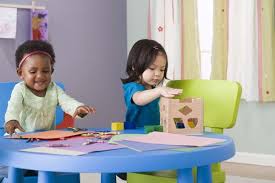As you interact with your child, remember children are not mini-adults. They are qualitatively different from adults in their ways of learning and thinking. Children : adults = tadpoles: frogs. To teach them, we have to think about the way they learn- not how we think they should learn.
Two important developmentally appropriate sequences for parents to be aware of are play and sorting/grouping.
For play, developmental psychologist Piaget named three broad cognitive play stages. First, practice play begins from birth and is dominant through the second year of life. Practice play involves exploring through the senses and motor movement. Second, symbolic play starts around three years old and involves a child using an object to represent something. So a child might substitute a block for a telephone. The third stage, around six or seven years of age, involves games with rules which require complex communication and cooperation.
Parten (1932, 1996) came up with her own stages of sequenced play as it relates to social development. First is solitary play. The second, seen frequently with two and three year olds, is parallel play in which children play beside another with similar toys. Associative play shows up at three and four and involves playing together without either child subordinating the other. Finally, children work for a common purpose in cooperative play.
The sorting/classifying sequence is important for parents to know when they ask their child to clean up their room. Three year olds can only focus on one aspect at a time- such as picking up all yellow items. Four year olds can classify three or so categories. So you can say all at once, “The yellows go here, the blues go there and the greens go over there.” Children find colors the easiest to sort/classify, followed by shapes and finally sizes. Once children can classify based on externalities they can start thinking in terms of the function of an object. So a parent would say, “All animals that swim in the ocean go in this box, etc.”
If a parent understands what a child is mentally and socially capable of, he can make more appropriate demands of the child. This helps parents and children avoid unnecessary anger and frustration.
The National Association of Educators of Young Children (NAEYC) sets overarching principles that every early education teacher should follow.
According to one of these principles, all teachers should understand the developmental sequences every child follows. Teaching and interacting using these age appropriate sequences will help the child learn more easily and cause fewer emotional/social problems. Ideally, parents should know these sequences as well.
The Texas Education Agency has a wonderful website that covers the many developmental sequences preschoolers go through such as writing and phonological awareness.
http://ritter.tea.state.tx.us/ed_init/pkguidelines/PKG_Final_100808.pdf
For more information, see Adapting Early Childhood Curricula for Children with Special Needs by Cook, Klein & Tessier and Total Learning by Hendrick & Weissman.



